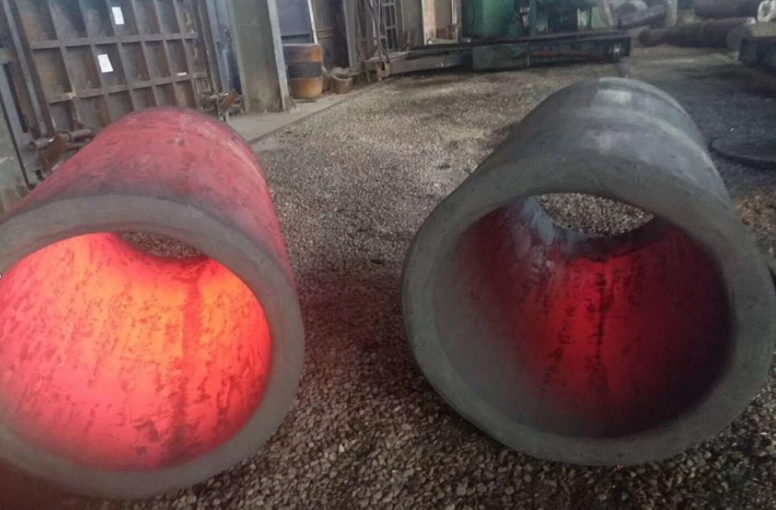- 25
- Sep
What problems may occur when forgings are quenched and cooled?
What problems may occur when forgings are quenched and cooled?
Today, I will take you to understand that the heat treatment quality problems that may occur during the quenching and cooling process of forgings are mainly: insufficient hardness after quenching, uneven hardness in the quenched state, insufficient quenching hardening depth; excessive hardness of the core after quenching; excessive quenching deformation; quenching cracking; The surface brightness is not enough after oil quenching.
Next, I will tell you in detail about the quality problems and solutions of forgings during quenching and cooling:
Insufficient hardness and insufficient hardening depth: The low quenching cooling rate is the reason for insufficient quenching hardness, uneven hardness and insufficient hardening depth of forgings. However, according to the actual material, shape, size and heat treatment requirements of the actual quenched forgings, it can be divided into high temperature There are different situations such as insufficient cooling rate in stages, insufficient cooling rate in medium and low temperature stages, and insufficient cooling rate in low temperature stages. for example. For small and medium forgings, insufficient quenching hardness is often caused by insufficient cooling rate in the middle and high temperature stages. When forgings with large modulus require a deeper hardened layer, it is very necessary to increase the low temperature cooling rate. For quenching oil, generally speaking, the oil has a short vapor film stage, a fast cooling rate at medium temperature, and a fast cooling rate at low temperature, which can often obtain high and uniform quenching hardness and sufficient quenching depth.
The way the workpiece is mounted also has a significant impact on the quenching cooling effect. It is necessary to make the quenching oil flow unobstructed, and to equip and use a good mixing device to get a better effect. Increasing the low-temperature cooling rate of the quenching medium used can often increase the depth of the hardened layer. In the case of the same carbon concentration distribution in the carburized layer, the use of a quenching oil with a higher low-temperature cooling rate tends to obtain a deeper quenching hardened layer. Therefore, the use of a quenching oil with a faster cooling rate can shorten the carburizing time of the workpiece correspondingly. Can obtain the required depth of quenching and hardening layer. The greater the depth of the carburized hardened layer required, the more obvious the effect of this method in shortening the carburizing time.
The hardness of the core after quenching is too high: this kind of problem may be related to the too fast cooling rate of the selected medium or the too high low temperature cooling rate of the medium. One of the solutions is to change the quenching oil to meet the requirements. The second method is to contact the quenching medium manufacturer and add appropriate additives to reduce the cooling rate of the quenching oil in the medium and low temperature. The third method is to switch to steel with lower hardenability.
Quenching deformation problem: Quenching deformation has caused many factories to brainstorm. According to custom, the solution to the deformation problem usually involves multiple departments, and the solution is often a comprehensive measure. The main cause of the deformation is attributed to insufficient cooling rate and uneven cooling, and on this basis, a solution principle method to increase the cooling rate and try to achieve uniform cooling is proposed. The measures to increase the quenching cooling rate should be added only when the measures in the same direction of action are selected reasonably. It can solve the quenching deformation problem of most forgings. For example, the deformation of the inner spline hole of the forging is often caused by the insufficient high temperature cooling rate of the selected quenching oil, or the excessively long vapor film stage of the oil. Increasing the high-temperature cooling rate of the oil and increasing the cooling rate of the oil in the entire cooling process can generally solve the problem of deformation of the inner spline hole. For forgings, especially the more precise forgings, a good selection and use of isothermal grading quenching oil is an indispensable measure to control deformation.
Quenching cracking of forgings: This problem mainly occurs in induction heating quenching. Choose a good water-based quenching medium, such as the PAG quenching medium commonly used at home and abroad to replace the original tap water, the problem will be solved. PAG medium is used for induction heating and quenching. High and uniform quenching hardness and deep and stable hardened layer can be obtained, and the risk of quenching cracking is extremely small.
Brightness problem: For occasions where this aspect is required, bright quenching oil or fast bright quenching oil should be used. Generally, the cooling rate of bright quenching oil is not high enough if the brightness of the bright quenching oil is good, and the brightness of the quenching oil with a high cooling rate is not good enough. In addition, the brightness of hot oil is generally poor. You can change the oil or add additives to improve the brightness.

